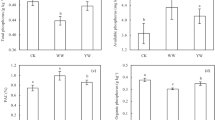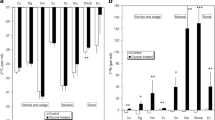Abstract
We used a P enrichment gradient in the Everglades to investigate patterns of the stable N isotopic ratio (δ15N) in peat profiles as an indicator of historic eutrophication of this wetland. We also tested two hypotheses to explain the effects of P on increased δ15N of organic matter including: (1) increased N mineralization/N loss, and (2) reduced isotopic discrimination during macrophyte N uptake. Spatial patterns of δ15N in surface litter and soil (0–10 cm) mimic those of the aboveground macrophytes (Typha domingensis Pers. and Cladium jamaicense Crantz). Peat profiles also show increased δ15N in the peat accumulated in areas near the historic P discharges since the early 1960s. The increased δ15N of bulk peat correlated well with both measured increases in soil total P and the historical beginning of nutrient discharges into this wetland. In 15-day bottle incubations of soil, added P had no effect on the δ15N of NH +4 and significantly increased the δ15N of water-extractable organic N. Measurements of surface soils collected during a field mesocosm experiment also revealed no significant effect of P on δ15N even after 5 years of P addition. In contrast, δ15N of leaf and root tissues of hydroponically grown Typha and Cladium were shown to increase up to 12‰ when grown at elevated levels of P and fixed levels of N (as NH +4 ). The magnitude of changes in δ15N resulting from altered discrimination during N uptake is significant compared with other mechanisms affecting plant δ15N, and suggests that this may be the dominant mechanism affecting δ15N of organic matter following P enrichment. The results of this study have implications for the interpretation of δ15N as an indicator of shifts in relative N limitation in wetland ecosystems, and also stress the importance of experimental validation in interpreting δ15N patterns.







Similar content being viewed by others
References
Amador J, Jones RD (1993) Nutrient limitations on microbial respiration in peat soils with different total phosphorus content. Soil Biol Biochem 25:793–801
Amundson R, Austin AT, Schuur EAG, Yoo K, Matzek V, Kendall C, et al. (2003) Global patterns of the isotopic composition of soil and plant nitrogen. Global Biogeochem Cycles 17
Bartow SM, Craft CB, Richardson CJ (1996) Reconstructing historical changes in Everglades plant community composition using pollen distributions in peat. J Lake Reserv Manage 12:313–322
Bedard-Haughn A, van Groenigen JW, van Kessel C (2003) Tracing 15N through landscapes: potential uses and precautions. J Hydrol 272:175–190
Benner R, Fogel ML, Sprague EK (1991) Diagenesis of belowground biomass of Spartina alterniflora in salt marsh sediments. Limnol Oceanogr 36:1358–1374
Brenner M, Whitmore TJ, Curtis JH, Hodell DA, Schelske CL (1999) Stable isotope (δ13C and δ15N) signatures of sedimented organic matter as indicators of historic lake trophic state. J Paleolimnol 22:205–221
Childers DL, Doren RF, Jones R, Noe GB, Rugge M, Scinto LJ (2003) Decadal change in vegetation and soil phosphorus pattern across the Everglades landscape. J Environ Qual 32:344–362
Clarkson BR, Schipper LA, Moyersoen B, Silvester WB (2005) Foliar 15N natural abundance indicates phosphorus limitation in bog species. Oecologia 144:550–557
Craft CB, Richardson CJ (1997) Relationships between soil nutrients and plant species composition in Everglades peatlands. J Environ Qual 26:224–232
Evans RD (2001) Physiological mechanisms influencing plant nitrogen isotope composition. Trends Plant Sci 6:121–126
Fogel ML, Tuross N (1999) Transformation of plant biochemicals to geological macromolecules during early diagenesis. Oecologia 120:336–346
Handley LL, Raven JA (1992) The use of natural abundance of nitrogen isotopes in plant physiology and ecology. Plant Cell Environ 15:965–985
Hogberg P (1990) Forests losing large quantities of nitrogen have elevated 15N/14N ratios. Oecologia 84:229–231
Hogberg P (1991) Development of 15N enrichment in a nitrogen-fertilized forest soil–plant system. Soil Biol Biochem 23:335–338
Inglett PW, Reddy KR (2006) Investigating the use of macrophyte stable C and N isotopic ratios as indicators of wetland eutrophication: Patterns in the P-affected Everglades. Limnol Oceanogr 51:2380–2387
Inglett PW, Reddy KR, McCormick PV (2004) Periphyton chemistry and nitrogenase activity in a northern Everglades ecosystem. Biogeochemistry 67:213–233
Koch MS, Reddy KR (1992) Distribution of soil and plant nutrients along a trophic gradient in the Florida Everglades. Soil Sci Soc Am J 56:1492–1499
Lehmann MF, Bernasconi SM, Barbieri A, McKenzie JA (2002) Preservation of organic matter and alteration of its carbon and nitrogen isotope composition during simulated and in situ early sedimentary diagenesis. Geochim Cosmochim Acta 66:3573–3584
Light SS, Dineen JW (1994) Water control in the Everglades: a historical perspective. In: Davis SM, Ogden JC (eds) Everglades: the ecosystem and its restoration. St. Lucie Press, Del Ray Beach, pp 47–84
Lorenzen B, Brix H, Schierup HH, Madsen TV (1998) Design and performance of the Phyto-Nutri-Tron: a system for controlling the root and shoot environment for whole-plant ecophysiological studies. Environ Exp Bot 39:141–157
Lorenzen B, Brix H, Mendelssohn IA, Mckee KL, Miao SL (2001) Growth, biomass allocation and nutrient use efficiency in Cladium jamaicense and Typha domingensis as affected by phosphorus and oxygen availability. Aquat Bot 70:117–133
Mariotti A, Germon JC, Hubert P, Kaiser P, Letolle R, Tardieux A, Tardieux P (1981) Experimental-determination of nitrogen kinetic isotope fractionation—some principles—illustration for the denitrification and nitrification processes. Plant Soil 62:413–430
Mariotti A, Landreau A, Simon B (1988) 15N isotope biogeochemistry and natural denitrification process in groundwater—application to the chalk aquifer of northern France. Geochim Cosmochim Acta 52:1869–1878
Martinelli LA, Piccolo MC, Townsend AR, Vitousek PM, Cuevas E, McDowell W et al (1999) Nitrogen stable isotopic composition of leaves and soil: tropical versus temperate forests. Biogeochemistry 46:45–65
McCormick PV, O’Dell MB (1996) Quantifying periphyton responses to phosphorus in the Florida Everglades: a synoptic-experimental approach. J North Am Benthol Soc 15:450–468
McCormick PV, Rawlik PS, Lurding K, Smith EP, Sklar FH (1996) Periphyton–water quality relationships along a nutrient gradient in the northern Florida Everglades. J N Am Benthol Soc 15:433–449
McKee KL, Feller IC, Popp M, Wanek W (2002) Mangrove isotopic (δ15N and δ13C) fractionation across a nitrogen vs. phosphorus limitation gradient. Ecology 83:1065–1075
Melillo JM, Aber JD, Linkins AE, Ricca A, Fry B, Nadelhoffer KJ (1989) Carbon and nitrogen dynamics along the decay continuum: plant litter to soil organic matter. Plant Soil 115:189–198
Nadelhoffer K, Fry B (1988) Controls on natural nitrogen-15 and carbon-13 abundances in forest soil organic matter. Soil Sci Soc Am J 52:1633–1640
Nadelhoffer K, Shaver G, Fry B, Giblin A, Johnson L, McKane R (1996) 15N natural abundances and N use by tundra plants. Oecologia 107:386–394
Newman S, McCormick PV, Miao SL, Laing JA, Kennedy WC, O’Dell MB (2004) The effect of phosphorus enrichment on the nutrient status of a northern Everglades slough. Wetl Ecol Manage 12:63–79
Novak M, Buzek F, Adamova M (1999) Vertical trends in δ13C, δ15N and δ34S ratios in bulk Sphagnum peat. Soil Biol Biochem 31:1343–1346
Orem WH, Holmes CW, Kendall C, Lerch HE, Bates AL, Silva SR et al (1999) Geochemistry of Florida Bay sediments: nutrient history at five sites in eastern and central Florida Bay. J Coast Res 15:1055–1071
Rejmánková E, Komárková J, Rejmanek M (2004) δN15 as an indicator of N2 fixation by cyanobacterial mats in tropical marshes. Biogeochemistry 67:353–368
Reddy KR, DeLaune RD, Debusk WF, Koch MS (1993) Long-term nutrient accumulation rates in the Everglades. Soil Sci Soc Am J 57:1147–1155
Reddy KR, Wang Y, Debusk WF, Fisher MM, Newman S (1998) Forms of soil phosphorus in selected hydrologic units of the Florida everglades. Soil Sci Soc Am J 62:1134–1147
Reddy KR, O’Connor GA, Schelske CL (1999) Phosphorus biogeochemistry in subtropical ecosystems. Lewis Publishers. Boca Raton, Fla.
Sorensen P, Jensen ES (1991) Sequential diffusion of ammonium and nitrate from soil extracts to a polytetrafluoroethylene trap for 15N determination. Anal Chim Acta 252:201–203
Stark JM, Hart SC (1996) Diffusion technique for preparing salt solutions, Kjeldahl digests, and persulfate digests for 15N analysis. Soil Sci Soc Am J 60:1846–1855
USEPA (1993) Methods for the determination of inorganic substances in environmental samples. EPA/600/R-93/100. EPA, Washington, D.C.
White JR, Reddy KR (2000) Influence of phosphorus loading on organic nitrogen mineralization of Everglades soils. Soil Sci Soc Am J 64:1525–1534
White JR, Reddy KR (2003) Nitrification and denitrification rates of Everglades wetland soils along a phosphorus-impacted gradient. J Environ Qual 32:2436–2443
Wooller M, Smallwood B, Scharler U, Jacobson M, Fogel M (2003) A taphonomic study of δ13C and δ15N values in Rhizophora mangle leaves for a multi-proxy approach to mangrove palaeoecology. Org Geochem 34:1259–1275
Acknowledgements
This work was funded in part by the National Science Foundation (grant DEB-0078368). The authors thank the following for their assistance in this work: Todd Osborne and Michael Manna for field and sampling assistance, Yu Wang for analytical support, and Bill Pothier for assistance with isotopic analyses. We also gratefully acknowledge Timothy Seastedt and two anonymous reviewers for comments and suggestions which greatly improved the quality of the manuscript. All of the experiments described in this study comply with the laws and regulations of the State of Florida and the United States of America.
Author information
Authors and Affiliations
Corresponding author
Additional information
Communicated by Tim Seastedt.
Rights and permissions
About this article
Cite this article
Inglett, P.W., Reddy, K.R., Newman, S. et al. Increased soil stable nitrogen isotopic ratio following phosphorus enrichment: historical patterns and tests of two hypotheses in a phosphorus-limited wetland. Oecologia 153, 99–109 (2007). https://doi.org/10.1007/s00442-007-0711-5
Received:
Accepted:
Published:
Issue Date:
DOI: https://doi.org/10.1007/s00442-007-0711-5




